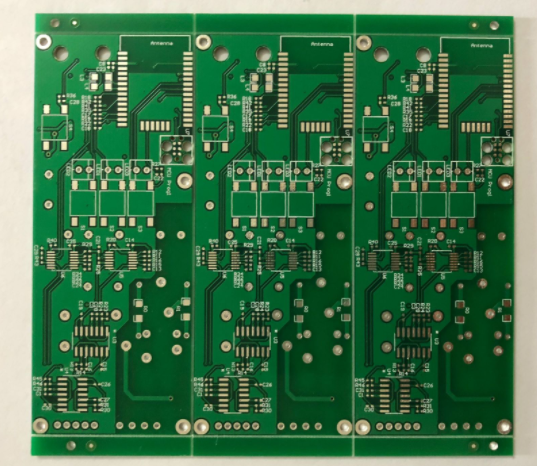The difference and application of aluminum substrate and glass fiber board
PCB board is printed circuit board, which is a general term for commonly used circuit boards. According to the raw materials, it is divided into: cardboard, semi-glass fiber board, fiberglass board, metal substrate, etc.
1. Fiberglass board (FR4, single-sided, double-sided, multilayer PCB circuit board, impedance board, blind buried via board), suitable for computers, mobile phones and other electronic digital products.
There are many ways to call fiberglass board, let’s first understand it together; FR-4 is also known as fiberglass board; fiberglass board; FR4 reinforcement board; FR-4 epoxy resin board; flame-retardant insulation board; epoxy Board, FR4 light board; epoxy glass cloth board; circuit board drilling backing board, generally used for the bottom layer of the soft package, and then covered with fabric, leather, etc., to make beautiful wall and ceiling decoration. It is widely used.
It has the characteristics of sound absorption, sound insulation, heat insulation, environmental protection, and flame retardant. Fiberglass board is a composite material made of epoxy resin, filler (Filler) and glass fiber.

The main technical characteristics and application of FR4 light board: stable electrical insulation performance, good flatness, smooth appearance, no pits, and the thickness exceeds the standard. It is suitable for products with high-performance electronic insulation requirements, such as FPC reinforcement boards and tin furnaces. High temperature resistant plate, carbon diaphragm, fine cruiser, PCB test frame, electrical (electrical) equipment insulation partition, insulation backing plate, transformer insulation, motor insulation, deflection coil terminal board, electronic switch insulation board, etc.
Fiberglass board is most widely used in conventional electrical, electronic, and digital products because of its good raw material properties. The price is higher than that of paper and semi-glass fiber. The detailed price is also different due to different product requirements.
Fiberglass board is also widely used in digital electronic products. Due to the special advantages of fiberglass board, it is widely used in PCB electronics manufacturers. The board of fiberglass board has V-groove, stamp hole, bridge and other boarding methods.
Second, aluminum substrates (single-sided aluminum substrates, double-sided aluminum substrates), aluminum substrates mainly have excellent heat dissipation performance, suitable for LED technology, and the bottom plate is made of aluminum.
The aluminum substrate is a metal-based copper clad laminate with outstanding heat dissipation function. Generally, a single panel is composed of a three-layer structure, which is a circuit layer (copper foil), an insulating layer and a metal bottom layer. For high-end applications, there are also plans for double-sided panels, with the structure of circuit layer, insulating layer, aluminum base, insulating layer, and circuit layer. A very small number of applications are multilayer boards, which can be formed by bonding ordinary multilayer boards with insulating layers and aluminum bases.
The aluminum substrate is a kind of PCB. The aluminum substrate is a metal-based printed board with high thermal conductivity. It is generally used in products that require heat dissipation such as solar energy and LED lights. However, the material of the circuit board is aluminum alloy. In the past, our general circuit board The material used is glass fiber, but because the LED heats up, the circuit board used in LED lamps is generally an aluminum substrate, which can conduct heat quickly. The circuit board used in other equipment or electrical appliances is still glass fiber board!
Most of the LED aluminum substrates are generally used in LED energy-saving lamps, and LED TVs will also be used. The first is to use them on objects that require heat conduction. The higher the LED current, the brighter the light, but they are afraid of high temperatures and excessive temperature. In addition to the lamp beads, there is light decay and so on.
The primary use of aluminum substrates and LED aluminum substrates:
1. Audio equipment: input and output amplifiers, balanced amplifiers, audio amplifiers, preamplifiers, power amplifiers, etc.
2. Power supply equipment: switching regulator, DC/AC converter, SW regulator, etc.
3. Communication electronic equipment: high-frequency amplifier `filtering appliance` transmission circuit.
4. Office automation equipment: motor drives, etc.
5. Car: electronic regulator `igniter` power controller, etc.
6. Computer: CPU board, floppy disk drive, power supply device, etc.
7. Power module: converter `solid relay` rectifier bridge, etc.
8. Lamps and lanterns: Following the promotion of energy-saving lamps, various energy-saving and gorgeous LED lamps are popular in shopping malls, and the aluminum substrates used in LED lamps have also begun to be used on a large scale.
As the primary substrate aluminum substrate required by the LED lighting industry, it can be said that it will be popular in the LED lighting era. With the widespread use of aluminum substrates, related aluminum substrate sub-board equipment will also increase accordingly.
3. Regarding the pricing of fiberglass panels and aluminum substrates: The thickness of FR4 fiberglass panels is 0.2 (ultra-thin). 0.4, 0.6. 0.8. 1.0. 1.2. 1.6. 2.0. 3.0. 3.2. In the meantime, the demand shows that the impedance board and the blind buried via board, the greater the difficulty, the more expensive the price.
The thinnest aluminum substrate can be 0.3 thick, and the thermal conductivity varies from 1.0.2.0.3.0. The higher the thermal conductivity, the higher the price.
The price of PCB board depends on. Plates, plate thickness, craftsmanship, and appearance, as well as the number of holes, the price of over-holes or long plates will be appropriately improved, and the appearance will be increased appropriately if it is more difficult to make. Generally speaking, aluminum substrates are more expensive, and aluminum substrates cannot be used for vias.